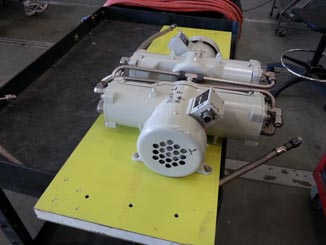Day54 to 57: Fifth Science Flight
Here we go again. Afterfinished the pre-flight and the science meeting we are ready to go airborne onemore time.
On Feb 26 at 9:59 am(PST) the Global Hawk 672 took off from Edwards Air Force base heading south toHawaii. I’msure you are wondering why we fly to this area so often. Well, our brilliantgroup of meteorologists and modelers always keep an eye on the weatherconditions and try to find the perfect locations to fulfill the objective ofour missions. For this flight, this area was characterized by the presence ofanticyclonic circulation, very cold air, considerable condensed water, and lowwater vapor concentrations. So, from our scientific point of view, this was anexciting flight.
On the other hand, theflight kept me busy most of the time. Once again, we performed nine verticalsprofile which forced us to power up and power down the instrument severaltimes. Besides, the absence of one of our satellite bands, made the samplingstrategy a little bit complicated. There were a lot of delays for gettingconfirmation of the commands we sent. However, one of the most exciting partswas to execute two of these vertical profiles near to the area where anothergroup was performing balloon measurements. Comparisons between our measurementsand the ones obtained by this group will be extremely helpful, not only for usbut also for all the scientific community interested on knowing the behavior ofozone and water vapor along the different layers of the atmosphere.
Day58 and 59: Sixth Science Flight
Our ATTREX 2013 lastflight I have a bittersweet feeling and a strangesensation which is hard to explain. I’m excited to complete our mission, but atthe same time it is sad for me to perform my last flight. I know I will be doit again in a blink of an eye, but believe me, with my lack of sleep it is hardto control my emotions. So, here we are again (and for the last time), on March1 around 6:15 am (PST) the Global Hawk 672 took off from Edwards Air Force Baseheading south of the equator and along the continental line. 24 hours ofexcitement, particularly in the southern part of the leg where we found a hugecloud which allowed us to take a lot of measurements. Without a doubt, one ofthe most entertaining flights! I collected a great amount of samples aroundthis cloud. At some point, I was even worried because I thought I would use allmy canisters here and I would not have anything else for our way back. However,the science mission crew was aware of the number of canisters left and workedwith us to maximize the their use.
By the end of theflight, just before landing, I noticed that many of us were exhausted. We didfeel the satisfaction of completing our last flight and the whole ATTREX 2013campaign was a success! We weresurrounded by the most amazing crew of pilots, managers, scientists andmodelers.
Next step, remove theinstruments for the aircraft, pack our supplies and go home!
Day60: GOOD BYE ATTREX 2013!
Wow! My two months ofadventures have come to an end. Everyone packed and one by one have left thehangar. Yes, the place that I used to call “my office” for the last monthslooks empty, but it feels full; full of happy memories, funny moments and somefrustrations.
It is hard to say goodbye, but for all us it is more like a SEE YOU LATER…we will back in a couple ofmonths to continue our mission. I’m sure ATTREX 2014 will be even better.
Thus, I don’t want tofinish my blog without saying THANK YOU! Yes THANK YOU to ALL my ATTREX team.We made it! You guys are the most incredible, fascinating and enthusiasticteam. It is an honor for me to be part of you, and I could not feel more proud.Let’s continue with our hard work (I know it is extremely HARD) but it is worthit.
I can’t wait to see youagain to discuss the results of our measurements, and to prepare our nextcampaign in the beautiful area of GUAM.
ATTREX 2014! Here weCome!!!!!!











 )
)
























